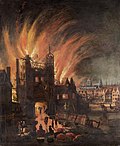Great Fire of London
The Great Fire of London happened in Central London in 1666. It lasted for just under five days, from 2nd September until 6th September.
 The Great Fire of London, September 1666. Painted by an unknown artist | |
| Date | 2–6 September 1666 |
|---|---|
| Cause | Bakery fire |
| Casualties | |
| 13,500 houses damaged | |
| 87 parish churches damaged | |
Estimates say that the fire destroyed the homes of 70,000 of the city's 80,000 residents.[1] It is not known how many people died in the fire. Only a few deaths are certain, but for many of the victims there were no records. The fire may have cremated many people, leaving no recognisable remains.
The fire threatened the aristocratic district of Westminster (the modern West End), Charles II's Palace of Whitehall, and most of the suburban slums, but it never reached these districts.[2]
Events
The fire started from a few oven sparks at the bakery of Thomas Farriner (or Farynor) on Pudding Lane. It began just after midnight on Sunday 2nd September and grew very quickly.
Firefighters of the time usually made firebreaks by destroying buildings around the fire so it could not spread. This did not happen quickly enough because Lord Mayor, Sir Thomas Bloodworth was not certain what to do. By the time he ordered such measures, it was too late. The Tower of London guard used gunpowder to make good firebreaks that stopped the fire from spreading to the east.
The fire pushed north on Monday into the center of the city. Some people thought fires were being set by French and Dutch people (who at the time were England's enemies in the Anglo-Dutch Wars).
On Thursday, the fire spread over most of the city. It destroyed St. Paul's Cathedral and crossed over the River Fleet. It almost reached Charles II's court at Whitehall.
Effects
The Great Fire caused major social and economic problems. Charles II strongly encouraged people to leave London to go and live elsewhere. He feared a London rebellion amongst the refugees who had lost their property.
Despite numerous radical proposals, London was reconstructed on essentially the same street plan used before the fire.[3]
Some historians think the fire may have helped to stop the Great Plague of London. Others say this is a myth.[4]
Historians know a lot about the Great Fire because Samuel Pepys kept a diary and survived the fire. When it started, he looked out of his window, saw the fire, and started writing about it.[5]
Damages
Estimates say the Great Fire destroyed 436 acres,[4] 13,200 houses,[4][6] 87 parish churches,[4] 44 Company Halls, the Royal Exchange,[6] the Custom House, St Paul's Cathedral,[6] the Bridewell Palace and other City prisons, the General Letter Office, and the three western city gates—Ludgate,[7] Newgate, and Aldersgate.[8]
Great Fire Of London Media
- Great Fire of London Map.png
Central London in 1666, with the burnt area shown in pink and outlined in dashes (Pudding Lane origin[a] marked with a green line)
- Firehooks.1612.png
"Firehooks" being used to fight a fire at Tiverton in Devon, England, 1612
Approximate damage by the evening of Sunday, 2 September, outlined in dashes (Pudding Lane origin[a] is short vertical road in lower right damage area).
Oil painting of the diarist Samuel Pepys, 1666
The London Gazette for 3–10 September, facsimile front page with an account of the Great Fire
Approximate damage by the evening of Monday, 3 September, outlined in dashes (Pudding Lane origin[a] is short vertical road in lower right damage area.)
Ludgate in flames, with St Paul's Cathedral in the distance (square tower without the spire) now catching flames. Oil painting by anonymous artist, c. 1670.
References
- ↑ Tinniswood, Adrian (2003). By permission of heaven: the story of the Great Fire of London. London: Jonathan Cape. ISBN 9780224062268. 4, 101.
- ↑ Porter, Roy (1994). London: a social history. Cambridge: Harvard. ISBN 9780674538382., 69–80.
- ↑ Reddaway, T.F. (1940). The rebuilding of London after the Great Fire. London: Jonathan Cape., 27.
- ↑ 4.0 4.1 4.2 4.3 "The Great Fire of London FAQs". The Monument. Retrieved 2025-04-02.
- ↑ "Diary entries from September 1666 (The Diary of Samuel Pepys)". The Diary of Samuel Pepys. Retrieved 2025-04-02.
- ↑ 6.0 6.1 6.2 "The Great Fire of London". www.london-fire.gov.uk. Retrieved 2025-04-02.
- ↑ "The Great Fire of London, with Ludgate and Old St. Paul's - YCBA Collections Search". collections.britishart.yale.edu. Retrieved 2025-04-02.
- ↑ Porter, 87–88.
Other websites
| Wikimedia Commons has media related to Lua error in Module:Commons_link at line 62: attempt to index field 'wikibase' (a nil value).. |
Cite error: There are <ref> tags on this page, but the references will not show without a {{Reflist|group=lower-alpha}} template or a <references group="lower-alpha"/> tag.






